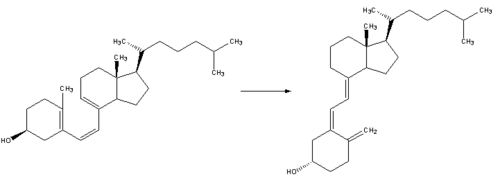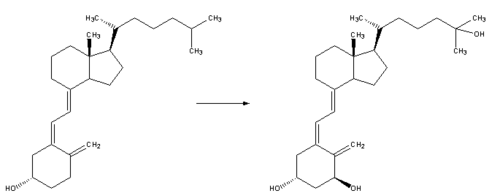Vitamin D Synthesis
Our parents always had many words of wisdom as we all grew up: take your vitamins, eat your vegetables, and go play outside. But why? Well, maybe they just were following the words of their parents or maybe they just needed a break. Either way, they were on to something. By taking our vitamins through dietary supplements or the foods we ate our bodies were being fortified with essential vitamins and minerals, like vitamin D and calcium which are directly related to healthier and stronger bones. The sun was also a major part of the equation. The sun catalyzes the reactions for those vitamins and minerals to do their jobs. So what is vitamin D?
Vitamin D is in a group of fat-soluble prohormomes, precursors to hormones. Alone prohormomes have little to no effect on the body. But through various mechanisms become very vital for the growth and development of health children and adults alike. There are 5 types of vitamin D, 1 through 5, that are responsible for various jobs. The most important types are Vitamin D2 and D3. Vitamin D2 is introduced into the body through our diets, especially with fish and green leafy vegetables. Vitamin D3 is synthesized using UVB light as a catalyst. Vitamin D3 most importantly regulated the calcium and phosphorous levels in the blood and promotes the formation of bone. It also promotes phyagocytosis and acts as an inhibitor for the parathyroid hormone.
How does the synthesis of usable vitamin D work? As most biochemical mechanisms, it is very specific and not exactly straight forward. Intermediates are produced before the active form of Vitamin D3 is produced.
First, 7-dehydrocholesterol, a steroid which is found in the deep epidermis, is struck by sunlight, specifically UVB (270-300 nm). The optimal UVB rays are found in a narrow window of 295 to 300 nm. Photolysis of the molecule occurs producing a pre-vitamin D3 structure. The intermediate structure then spontaneously isomerizes into antarafacial hydride forming vitamin D in the form of cholecalciferol. The vitamin D3 is hydroxyolated in the liver. The active form of vitamin D3, calcitriol, is then transferred by binding proteins to the needy organs of the body.

The UVB light penetrates deep into the epidermis layer of the skin. Most of the 7-dehydrocholesterol is found in the stratum basale and stratum spinosum, which is where the synthesis of calcitriol begins.
UVB light photoyliszes 7-dehydrocholesterol forming the pre-vitamin D3 molecule.

The intermediate pre-vitamin D3 molecule then isomerizes
spontaneously to form antarafacial hydride forming the vitamin D in the
form of
cholecalciferol.

The vitamin D3 is hydroxyolated in the liver. The active form of vitamin D3, calcitriol, is then transferred by binding proteins to the needy organs of the body.
How do people become deficient in vitamin D3? Deficiencies are caused by low levels of vitamin D due to lack of sun exposure or dietary intake. During the industrial revolution, 19th century, urban environments were becoming populated with companies increasing smog and pollutants into the air. During that explosion vitamin D3 deficiencies were on the rise. Young children were being affected and bone development was altered. It wasn’t until the 1930’s did they determine that lack of vitamin D3 was the cause the mis-development of children’s bones and milk companies began to fortify their milk.
Vitamin D3 deficiencies are not limited to smog in large cities but other factors also can be contributors, which revolve around the limited amount of UVB exposure. Some causes can include but are not limited to geographical location, latitude, time of year, cloud coverage, and even the amount of melanin in the skin versus the time of UVB exposure.
Disorders which are commonly associated with vitamin D3 deficiencies are rickets, ostomalaica, osteoporosis, and cancers. Rickets is the softening or weakening of bones in young children. Rickets usually occurs during periods of physiological rapid growth when large amounts of calcium are needed. Ostomalaica, is similar to rickets, but occurs in adults. Osteoporosis is the loss of normal bone density causing fragile bones in the older population. Seventeen different varieties have been linked to low levels of vitamin D3.
How much vitamin D is enough? At this point, not enough information or data is available to have the federal government regulate levels through the RDA (recommended daily allowance); however, a system AI (adequate intake) has been established to give the public a guideline. Men, women, and children all require vitamin D3 in their diets. The guideline is based off of age rather than sex. As you age more vitamin D3 is required.
Age |
Dosage |
19-50 |
200 IU |
51-69 |
400 IU |
70 and older |
600 IU |
| Sunscreen Chemistry |
Sunscreen verses Sunblock |
Home |
| Discovery of Sunscreen | Active Ingredients |
Skin Cancer |
| Portrait of the Sun | SPF |
Want to Learn More? |
| Ultra-Violet Radiation | Lesson Plans |
